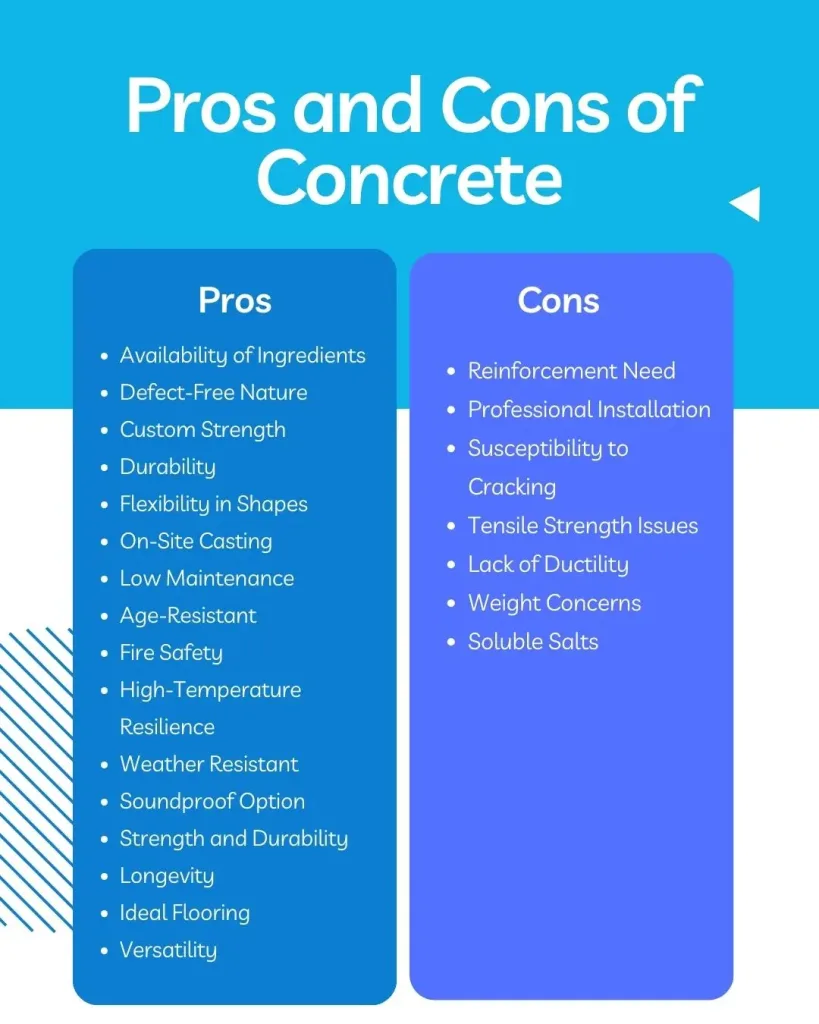Concrete is widely used in construction due to its many benefits. It’s easy to find its materials, can be shaped as needed, and is known for its strength and long life. But it’s not just about the good things. There are also some drawbacks when using concrete, like the need for added strength or the potential for cracks. In this article, we’ll dive deep into the pros and cons of using concrete in construction.
Table of Contents
Pros of Concrete
- Availability of Ingredients: Most regions have abundant supplies of the sand, gravel, and cement used in concrete. This widespread availability ensures a consistent material source.
- Defect-Free Nature: Unlike some natural materials, concrete is engineered to be free from innate flaws. This ensures a more uniform strength and appearance in structures.
- Custom Strength: Concrete mixtures can be tailored to achieve specific strengths based on project needs. This flexibility allows for optimal performance in varied applications.
- Durability: Concrete’s lifespan is impressively long.
- Flexibility in Shapes: Fresh concrete can be poured into any mold to achieve a desired shape.
- On-Site Casting: Concrete can be mixed and cast directly at the construction site. This reduces transportation costs and potential damages during transit.
- Low Maintenance: Once concrete is set and cured, it requires minimal upkeep. This makes it cost-effective over its lifespan.
- Age-Resistant: Concrete’s quality doesn’t decline notably over time.
- Fire Safety: Its non-flammable nature makes buildings safer from fires.
- High-Temperature Resilience: Concrete can withstand exposure to high temperatures without losing its structural integrity. This is especially valuable in industrial settings or regions with extreme heat.
- Weather Resistant: Concrete structures are robust against various weather conditions, from rain to wind. This makes them ideal for use in diverse climates.
- Soundproof Option: Using cinder concrete can help in noise reduction.
- Strength and Durability: Concrete can handle significant stress, making it ideal for heavy-duty applications. Its robust nature ensures stability and longevity for structures.
- Longevity: For example, the Pantheon’s concrete dome in Rome, built around 120-124 AD, still stands today.
- Ideal Flooring: Concrete isn’t just a base; it’s also a stylish flooring choice when finished professionally.
- Versatility: Concrete’s adaptability extends to various construction needs, from bridges to home floors. Its varied applications make it a go-to material for diverse projects.
Cons of Concrete
- Reinforcement Need: Concrete often requires steel rods or mesh for better tensile strength.
- Professional Installation: Correct mixing, installing, and curing need expert hands. Inexperienced workers can jeopardize a project.
- Susceptibility to Cracking: If concrete isn’t mixed, poured, or cured correctly, it might develop cracks. These cracks can diminish its strength and overall lifespan, making its application potentially risky.
- Tensile Strength Issues: Concrete’s tensile strength is lower compared to many other building materials. This limitation means it can crack under tension unless reinforced.
- Lack of Ductility: Once hardened, concrete can’t bend or stretch much without breaking.
- Weight Concerns: Concrete is heavy in relation to its strength, which can pose challenges in certain construction scenarios. This weight can necessitate additional support structures or limit its use in some projects.
- Soluble Salts: Some concrete mixtures can contain soluble salts, leading to efflorescence, a white powdery residue. This not only affects aesthetics but can also indicate deeper moisture issues within the structure. You can refer to this article to learn what concrete efflorescence is.

Conclusion
In conclusion, concrete stands out as a reliable option in the field of construction, with many advantages such as easy availability, customizability, durability, and versatility. Because it can be shaped in many ways and lasts a long time, it is used in a wide range of construction projects. But it’s important to be aware of its flaws, such as the need for reinforcement, the chance of cracking, and specific weight issues. Having a comprehensive understanding of both its advantages and drawbacks ensures that concrete can be used effectively and efficiently in construction projects.












